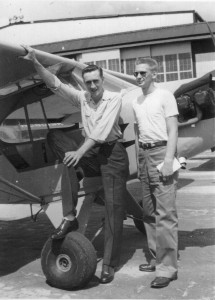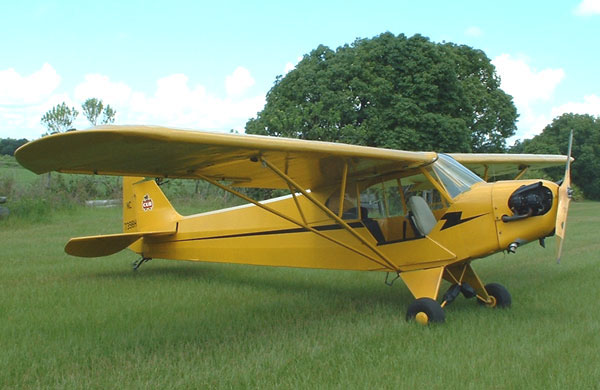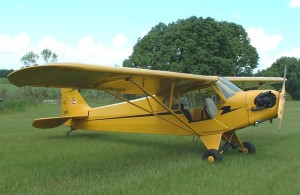
Stan Sears (on the left) and another student take time out from lessons to get their picture taken in front of a Piper J-3 Cub.
By Stan Sears
The ground below is spinning enchantingly clockwise as it grows ever closer. I sit motionless, pinned to the seat by centrifugal force and totally enthralled by the whirling, earth-colored kaleidoscope that fills the front window of the cockpit. This is fun! My flight instructor, Frank, finally turns his head and looks back over his shoulder at me, with a cocked eyebrow that clearly asks, “What the hell…?”
I snap out of my rapt stupor, remembering that the idea of this exercise is to recover from the tailspin quickly. Several spins too late, I kick the right rudder pedal and push forward on the stick—an exceedingly unnatural act in an already-diving airplane! The spin stops, and the dive becomes impressively faster. Thinking more about Frank’s inclination for trenchant commentary than about what I’m doing, I quickly haul back on the stick to recover from the dive.
It’s too quick. We pull out too suddenly, producing G-forces marginally beyond the modest design limits intended by the Piper Aircraft Corporation. The brave and willing J-3 Cub fights mightily to stay in one piece as we level off violently—many miles per hour too fast and several hundred feet closer to the ground than we should be. The recovery is exciting, but not admirable. We could’ve lost the wings. We could’ve swooped up into another stall—even another spin.
With the thrill gone, I grit my teeth as I anticipate Frank’s likely reaction to my substandard performance. He turns once more and stares back at me with a mournful mixture of disbelief and despair.
“OK, ‘Ace,’ somehow we’re still alive,” he says. “Let’s head back to the field and give thanks.”
This particular small adventure is over—unless he wants me to try the landing.
When I was a child, I wanted to grow up to be an ace fighter pilot. When, in the eyes of the U.S. government, I was in fact grown up (i.e. draftable), I prudently joined the U.S. Air Force before my selective service number came up. I missed becoming an ace, but I did fly an airplane—more or less. There are two perfectly honorable reasons that I never shot down any enemy aircraft: 1) there were no guns on a Piper Cub; 2) there was no war in 1950 Augusta, Ga.
I first met the mild-mannered Piper J-3 Cub at Bush Field, at the time a small airport, six miles outside of Augusta. I was an airman first class, stationed at nearby Camp Gordon, an Army base to which I had been incongruously assigned to attend an electronics school. It wasn’t only strange to be an airman with the Army, but—to me, anyway—it felt unfair that I should have to pay for flying lessons when I was in the Air Force. Of course, I was—as I recall—only paying 5 dollars per half hour, with the benefit of Frank’s incisive satirical comments about my flying.
Frank was a good instructor, although, in my youthful exuberance, I didn’t always think so. He was a drawling native Georgian in his mid-30s, laconic and unexcitable—valuable assets for any flight instructor. We shared an initial difficulty with each other’s accents. I was a Yankee from unpronounceable Massachusetts, 19 and bulletproof, who already knew how to fly a plane, and mistook that knowledge for actually being “able to.”
Frank always tried to make me understand that learning to fly wasn’t supposed to be like an amusement park ride. Often, his terse comments about some dumb flying error of mine were more effective than any long invective would’ve been. For instance, on my second flight with him in the Cub, I began feeling fairly confident, a premature judgment on my part that resulted in my throwing the plane around with what, I thought, were crisp, authoritative movements of the controls. After whipping us into what was supposed to be a level, 90-degree turn, but ended up being a 110-degree turn with a loss of 200 feet of altitude, he turned and, nodding his head slowly, gave me that calm stare.
“Ah’m deeply impressed,” he said. “Now, just for the sheer hell of it, show me a smooth, accurate turn.” Red-faced, I did—then, and every time after.
The J-3 Cub was a great trainer, and in the U.S., it was the plane of choice for most learners in the mid-twentieth century, as well as the primary trainer for some 75 percent of military pilots at the beginning of WWII. It was great because it was simple, straightforward, trustworthy and easy to fly, but with just enough idiosyncrasies to keep the student alert without actually killing him—something that couldn’t be said of most military basic trainers.
The small Cub had a minimum of interior comforts and flying aids. It offered two small, low-back seats, a pair of joysticks and rudder pedals, two throttles and a pair of alleged brake pedals for brakes that no one trusted. It also provided six basic flight instruments that were mostly obscured from the view of the student in the rear seat by the bulk of the instructor in the front seat, a pair of microphones and headsets, a few switches and knobs including carburetor and cabin heat, and fuel flow control. In the nose was a Continental 65-hp engine, comparable to those found on present-day power mowers. It wasn’t much, but it was sufficient, and while operating, it demanded enough attention to keep the pilot on his toes.
My first training flight in the J-3 was also my first ride in any airplane; 19 years of yearning were finally being requited. There’s simply no sensation quite like lifting off the ground in a plane. Nothing to match the feeling of looking down at the earth below, and, certainly, no equal to the spine-tingling awareness of having three-dimensional command over all of the space around you. After clearing the pattern, Frank turned over the controls to me and optimistically requested straight and level flight. He then kicked open the clamshell doors on the right side of the plane.
Wow! The roar of the engine, the howling rush of air against cheeks and hair and the vibration from the very heart of the plane traveling up my arms and legs let me know I was in charge of this “living” thing. These sensory inputs were exhilarating beyond imagination. Filled with heady power, I tilted my head into the whistling slipstream to look at the automotive traffic a thousand feet below on the highway. The cars traveling in our direction were—what?—passing us!
In the days ahead, as I slowly acquired flying skills, I learned the satisfying joys of flying low and slow. The pleasure of the Cub was the trip, not the destination. As Robert Louis Stevenson said, “It is a better thing to travel than to arrive.” He’d have loved the Cub. Some of the trickiest maneuvers were those that seemed easy. My first takeoff was deceptively simple. One helpful thing about the Cub was that, with a slight headwind, if you did nothing to get in its way, it would almost take off by itself. So I didn’t, and it almost did. We were in the air before I’d realized what happened, and Frank was quickly on the controls, lowering the nose slightly. The Cub doesn’t hit the air running; it prefers leveling off right after the wheels break ground in order to gain more flying speed.
“Don’t rush it,” Frank said in his slow drawl. “Y’all still got 25 minutes left to crash in.”
I liked it better in the air, where my exuberance provided many unintended thrills. Power stalls in the Cub, performed eccentrically, were fun. You hauled back on the stick without adding power, and kept the wings level while the nose went up and the speed went down. As stalling speed approached, your feet danced on the rudder pedals, holding the nose straight up, so the plane wouldn’t fall off to one side in a spin. There was a brief, exciting moment when the plane almost stopped, suspended tail down, and you felt like it would fall backwards. Then you pushed the stick forward—you’d better! —which dropped the nose to regain flying speed. Whoop-dee-doo!
“Just a leeetle drawn out there, pard,” Frank commented.
“Flying” the Cub turned out to be the easiest part. Handling it on the ground was more demanding. A thorough preflight check, for which there was no charge, always preceded a lesson.
“We don’t charge for enhancin’ the safety of our own hides,” Frank explained.
Taxiing the plane, with its nose in the air like some snooty debutante, required the pilot to make a series of “S” turns in order to see straight ahead. The Cub was a tail dragger; during all taxi maneuvers, the tail needs to be kept on the ground: i.e. upwind, stick back; downwind, stick forward; side wind, stick to windward. In practicing these things, the learning speed was exponential to the wind speed. So were Frank’s instructive comments: “Are you partial to ground loops?”
The hoped-for symmetry of a flight included a good takeoff and landing. A pilot’s proficiency is defined, in a large part, by his ability to maintain a successful relationship with the ground—that hard place where planes must eventually return to, one way or another. Leaving the ground and returning were always my bugaboos. Rolling down the runway, I had a tendency to over-correct with the rudder pedals, resulting in some homely swerves and picturesque takeoffs. No runway was too wide for me to touch both edges. Landings were equally quaint.
To land a Cub, the plane, of course, has to be completely stalled, preferably just a few inches above the surface of the runway. (In a pinch, the grass, dirt or secondary pavement off the runway will do, but don’t expect any applause for it.) To stall the Cub, you have to haul the stick hard, as far back as it will go, sometimes even using both hands—the last fraction of an inch makes all the difference. If the plane stalls too far above the runway, it becomes a falling object, and after it hits, a bouncing object. In other words, if the plane quits flying before the pilot quits trying to land it, the embarrassing result is a series of ungainly, bounding leaps down (or off) the runway until all of the energy in the springy landing gear is expended, and the plane becomes merely a rolling, often swerving, object. Sometimes, all of the instructor’s patience is likewise expended, but Frank was usually long-suffering.
“I hope y’all don’t mind if I sign your logbook with an assumed name,” he’d say.
I finally got to the point where I could take us up and down uneventfully, except maybe for crosswind takeoffs and landings. Coordinated stick and rudder movements had become natural, and the required opposite stick and rudder for crosswind situations felt decidedly contrary. However, shooting takeoffs and landings for seven consecutive lesson finally advanced to where even I believed I was merely colorful, not dangerous. I stilled bounced about half the time, but pilots had always called landings “controlled crashes,” and my vaults down the runway were graphic demonstrations of that concept. At the end of six hours and 45 minutes at the controls of a J-3—some of which were with a couple other instructors—the consensus was that I could probably fly alone without hurting myself or bending the airplane. On my next lesson, they would turn me loose after one accompanied flight around the pattern, and let destiny take its course.
Unfortunately, destiny had other ideas. By now, I had completed my electronics training, and the USAF cut orders to send me to England the following week, without even a chance to say thanks and goodbye to Frank. More than that, it was to be 50 years before I became aeronautically colorful again.












